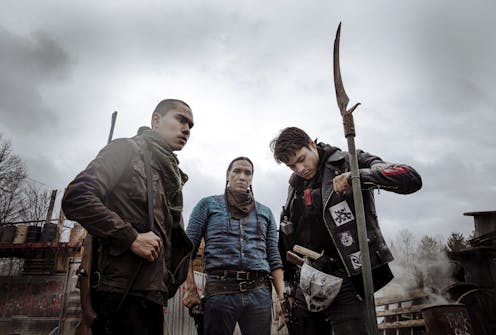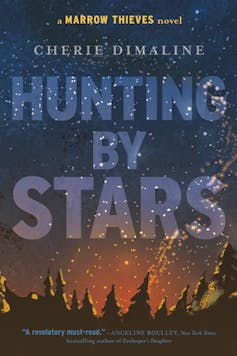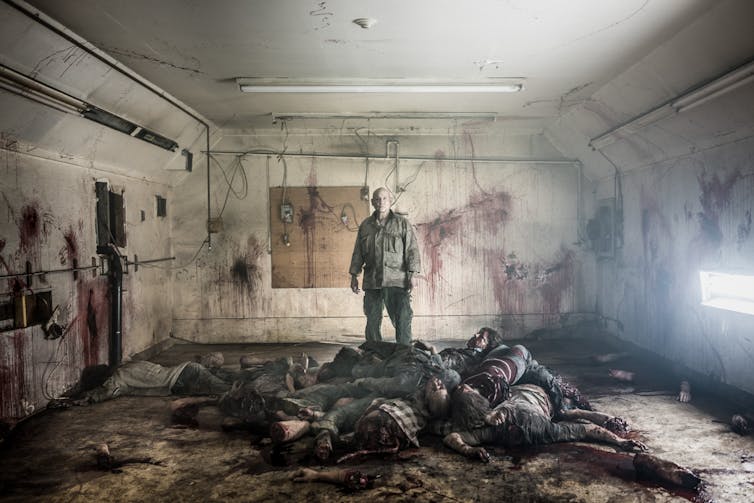
With many provinces across Canada lifting vaccine and mask mandates, anxieties are high. If COVID-19 is becoming endemic, we must search for what philosopher Jonathan Lear calls “radical hope.”
Read more: Radical hope: What young dreamers in literature can teach us about COVID-19
However, alongside trauma and particularly in times of pandemics throughout history, hope can take the form of stories about resilience. And for Indigenous people in particular, who have disproportionately experienced the effects of the pandemic, what better way to find hope than to turn to Indigenous survivors in post-apocalyptic narratives?
Survival stories
Métis author Cherie Dimaline provides us the opportunity to do just this. Dimaline is best known for The Marrow Thieves, which won the Governor General’s Literary Award and the Kirkus Prize. The Marrow Thieves is listed as one of TIME magazine’s Best YA Books of All Time.
The novel was written in response to the suicide epidemic within Indigenous communities. During her work with Indigenous youth, Dimaline wanted to show them a viable future where they could be the heroes.
The Marrow Thieves and its sequel, Hunting by Stars, follow Métis protagonist Frenchie and his found family of other Indigenous survivors as they roam a post-apocalyptic wasteland ravaged by climate change. In this new world, everyone except Indigenous people have lost the ability to dream. Without dreams, people go mad — killing others and committing suicide.
Governments respond by establishing schools inspired by the residential school system, and characters called “recruiters” search for Indigenous survivors to bring back to the schools to be “harvested.” The marrow within the bones of Indigenous people contains dreams, and by harvesting and consuming the marrow, non-Indigenous survivors can finally dream.
Hunting by Stars reflects contemporary concerns about residential schools as well as contagion:
“…medical masks hanging from their ears like hand-me-down jewelry. They had the plague. Trash cans at the end of each driveway were heaped with syringes, so many vaccinations and cures thrown out because none would work. The people stumbled into one another, knocking over cans and crunching through needles. They had that look, the one that let you know they were dreamless.”
Story and hope
In Dimaline’s novels, there is the Story: as Indigenous survivors tell their stories, the overarching Story changes slightly to include these new voices. Story, with a capital “s,” is comprised of a “shared oral history,” produced by the various characters’ narratives.
Miigwans, the Elder figure in the novel is responsible for telling Story to ensure the younger Indigenous survivors in the novel remember their history. Therefore, his telling of Story ensures that it will never be forgotten. However, Story is not just the history of the Indigenous characters in the novel; Story is the history of everyone living in Canada, both Indigenous and non-Indigenous peoples.
Story includes climate change, pipelines, colonialism, Treaties and the residential school system.
Dimaline admits that stories are how she understands herself and her community.

Given that Dimaline’s original inspiration was to bring hope to Indigenous youth amidst rising suicide rates, the relationship between Story and hope cannot be overlooked.
Dimaline’s novels resonate in today’s world. The re-introduction of residential schools in the world of Dimaline’s novels is timely, given recent confirmations of unmarked burial sites at former residential school locations throughout Canada.
Plagues and zombies
Story plays a similar role in Mi'kmaq director Jeff Barnaby’s 2019 zombie film, Blood Quantum. In Blood Quantum, a zombie-producing plague has ravaged the world, but Indigenous people find themselves immune to the virus. They establish a safe zone on the fictional Red Crow Reservation and protect both Indigenous and non-Indigenous survivors. However, the inclusion of the latter is a point of contention for some characters.
In the film, there are a few animated scenes that represent Story. In the final animated scene, an elder named Gisigu appears to perish beneath a mass of zombies. However, the scene changes to animation, and Gisigu emerges victorious. Gisigu may have perished in the material world, but in Story, he lives on. When animated Gisigu emerges from beneath the mass, he vows never to let the zombies pass, protecting the future of his surviving Indigenous family.

Understanding through Story
For many Indigenous people, storytelling is a form of reclamation — what Anishnaabe writer Gerald Vizenor would call “survivance,” a portmanteau of survival and resistance. The concept relies on the use of stories to ensure the continued presence of Indigenous people.
In response to the recent confirmations of unmarked burial sites at residential schools, survivors are recounting stories about those who unfortunately did not survive. Doing so is survivance — these stories bring lost Indigenous children into the present and give those who survived as well as those who unfortunately did not, voice and agency.
As a third-generation residential school survivor, I cannot possibly understand what my grandmother experienced inside the schools. I can, however, read Story and begin to understand my own part in Story. Therefore, we can all learn a little something about ourselves and our world from Indigenous survival stories.
Krista Collier-Jarvis does not work for, consult, own shares in or receive funding from any company or organisation that would benefit from this article, and has disclosed no relevant affiliations beyond their academic appointment.
This article was originally published on The Conversation. Read the original article.







